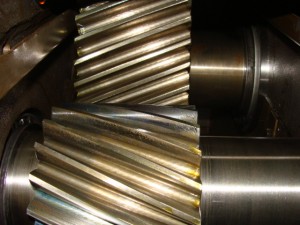 Within a Falk gearbox reducer, gears convey power from one rotating shaft to another through the interaction of the gear teeth. Each pair of teeth on two interacting gears acts as a lever to transmit torque, or rotary force, from one shaft to the other. The relative size of the gears determines the lengths of the lever elements involved and therefore the ratio of force/speed multiplication.
Within a Falk gearbox reducer, gears convey power from one rotating shaft to another through the interaction of the gear teeth. Each pair of teeth on two interacting gears acts as a lever to transmit torque, or rotary force, from one shaft to the other. The relative size of the gears determines the lengths of the lever elements involved and therefore the ratio of force/speed multiplication.
How Gear Teeth Determine Gear Ratios
Gear teeth must be machined as discrete elements, with whole numbers of teeth on each gear. To properly mesh together inside a gearbox reducer, the spacing between gear teeth – and hence the “pitch” or number of teeth per inch of gear diameter – determines the relative size and ratios between the gears.
Gears must also have a certain minimum number of teeth to be manufactured. Therefore, it is common to see ratios such as 36 teeth on one gear and 12 teeth on the other, for an effective ratio of 36:12, or three to one. The larger gear will be three times the diameter of the smaller and will have three times as many teeth.
A Falk gearbox uses sets of gear pairs combined to increase the speed/torque multiplication in a power transmission system. When primarily used to reduce speed, such a gear train system is referred to as a gearbox reducer. These are common in industries that need a high torque output for load lifting or hauling such as in cranes and logging equipment. This allows loads weighing many tons to be lifted with relatively small -capacity engines. For example, a motor generating 100 foot-pounds of torque, connected to a 100:1 gearbox reducer, could produce 10,000 foot-pounds of torque at the output shaft. The output shaft speed would be also be reduced by 100 compared to the motor speed.
Gear Sizes and Precision
Industrial standardization has led to the production of a limited number of gear pitch sizes on specified gear diameters. Unusual sizes are available for custom applications, but for the majority of applications, the standard sizes are chosen and the gearbox reducer is built to accommodate them. A Falk gearbox will include the gear dimensions in its design information.
Various applications also require specific levels of precision in manufacture. Instrumentation gears require the highest precision, while non-critical equipment gears that are used only occasionally may get by with relatively low levels of precision in manufacture. The greater the precision, the greater the cost of manufacture – and the greater the cost of the gearbox. Where long life and quiet operation are considerations, greater precision will be an important selection criterion.
Selecting Replacement Gears
When gearbox repairs are required, a qualified repair shop can help reduce repair costs by providing solutions such as refurbishing the unit instead of replacing it. A Falk gearbox can often be rebuilt at a substantial cost savings over purchase of a new unit. Used gears and other components can often be obtained from Falk surplus suppliers.
When looking for replacement gears, the following considerations must be kept in mind:
- Dimensions. Gear diameter and length must match the original to maintain proper geometry and operating clearances.
- Material. For proper strength, gear materials must match.
- Hardness. The surface hardness and core hardness must be compatible with the other components in the system for best Falk gearbox longevity. Toughness and wear are both affected by material hardness.
- Precision. The level of precision must be considered. The replacement parts must be within the tolerances required by the manufacturer for proper operation. Higher precision gears may be necessary.
Once a gearbox reducer is rebuilt, the installation and maintenance procedures from the manufacturer should again be followed for best service life.
Posted under Machinery Maintenance, Tips and Tricks on Tuesday, September 20th, 2011
